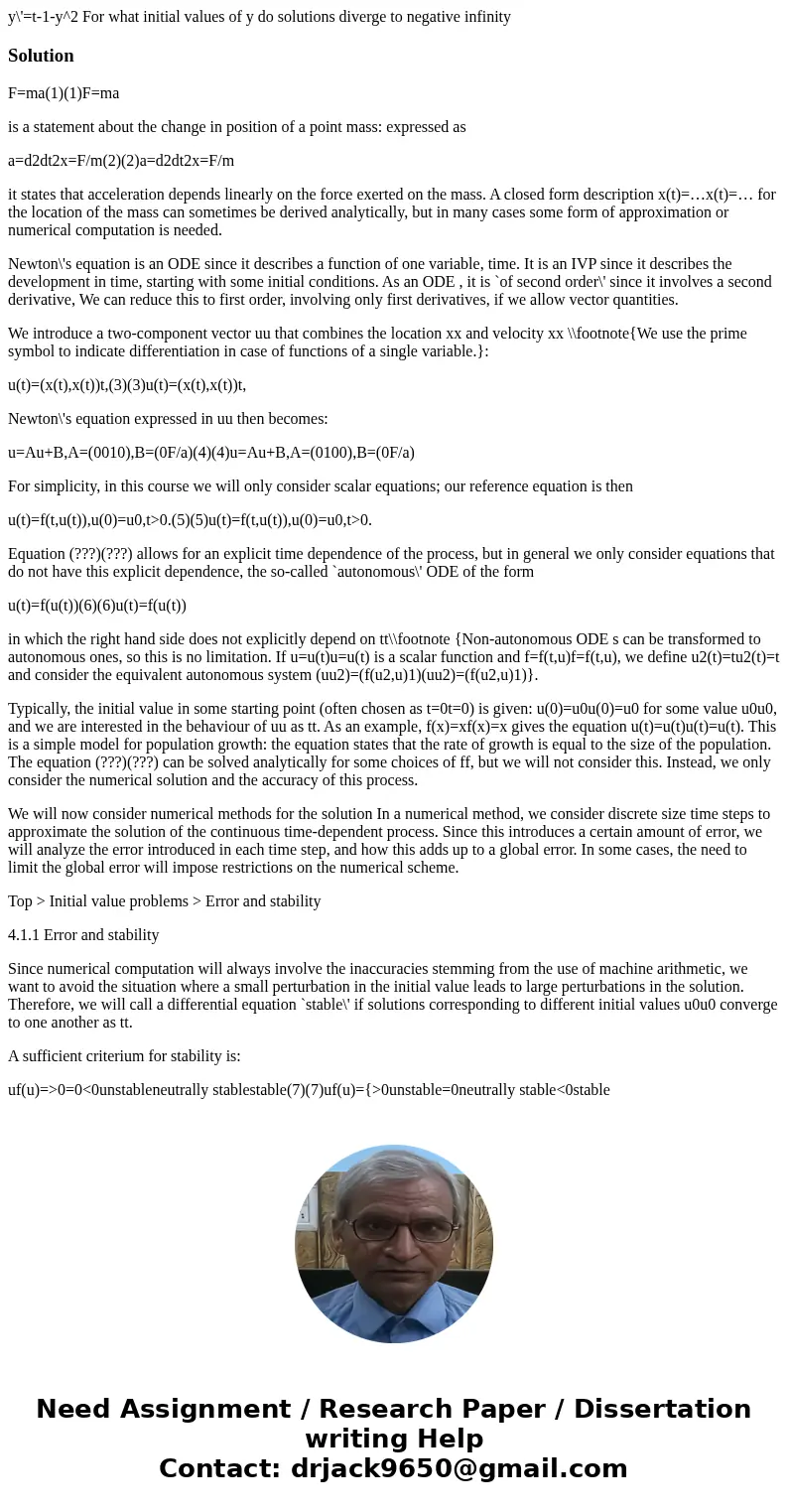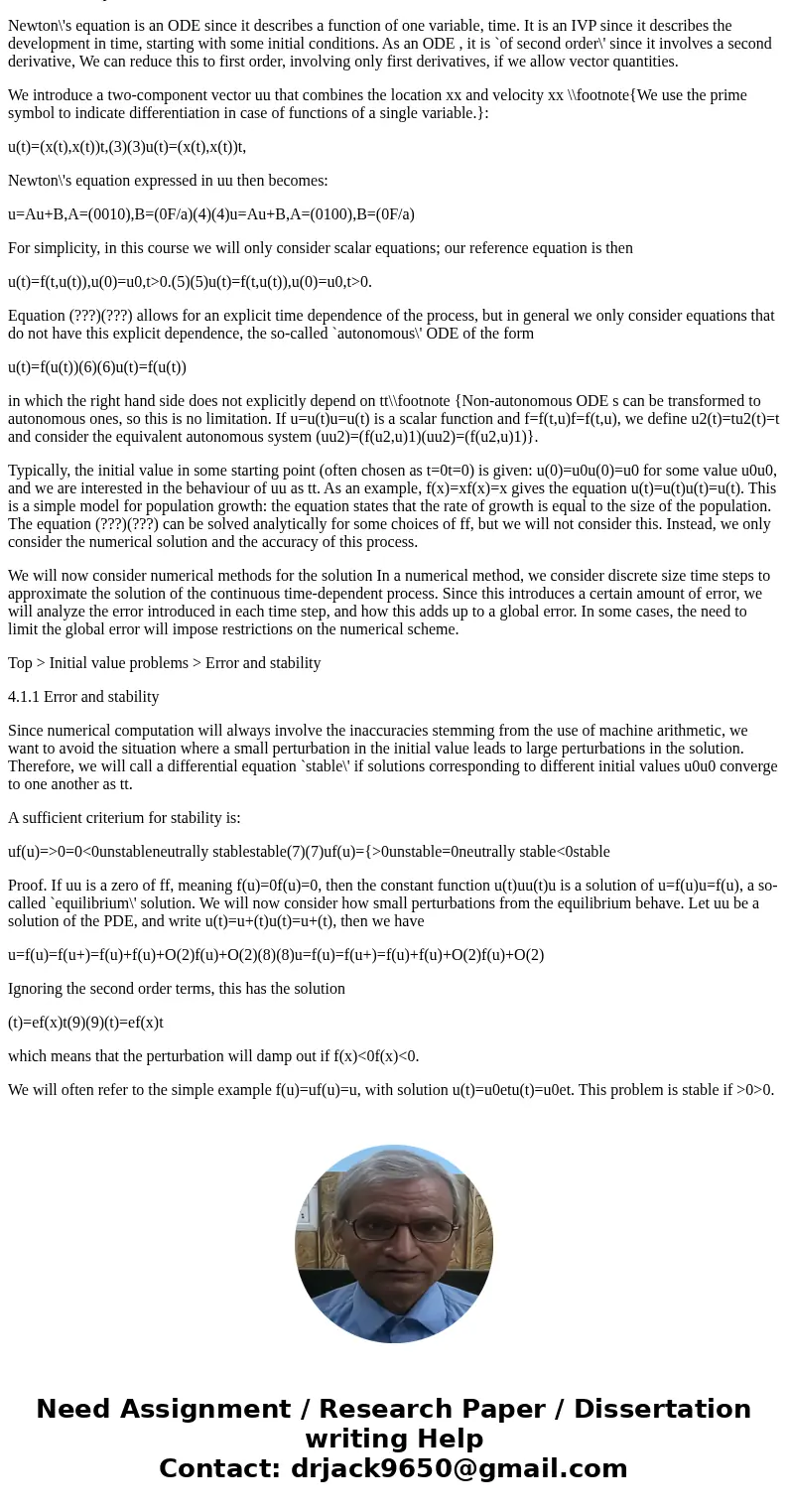yt1y2 For what initial values of y do solutions diverge to n
y\'=t-1-y^2 For what initial values of y do solutions diverge to negative infinity
Solution
F=ma(1)(1)F=ma
is a statement about the change in position of a point mass: expressed as
a=d2dt2x=F/m(2)(2)a=d2dt2x=F/m
it states that acceleration depends linearly on the force exerted on the mass. A closed form description x(t)=…x(t)=… for the location of the mass can sometimes be derived analytically, but in many cases some form of approximation or numerical computation is needed.
Newton\'s equation is an ODE since it describes a function of one variable, time. It is an IVP since it describes the development in time, starting with some initial conditions. As an ODE , it is `of second order\' since it involves a second derivative, We can reduce this to first order, involving only first derivatives, if we allow vector quantities.
We introduce a two-component vector uu that combines the location xx and velocity xx \\footnote{We use the prime symbol to indicate differentiation in case of functions of a single variable.}:
u(t)=(x(t),x(t))t,(3)(3)u(t)=(x(t),x(t))t,
Newton\'s equation expressed in uu then becomes:
u=Au+B,A=(0010),B=(0F/a)(4)(4)u=Au+B,A=(0100),B=(0F/a)
For simplicity, in this course we will only consider scalar equations; our reference equation is then
u(t)=f(t,u(t)),u(0)=u0,t>0.(5)(5)u(t)=f(t,u(t)),u(0)=u0,t>0.
Equation (???)(???) allows for an explicit time dependence of the process, but in general we only consider equations that do not have this explicit dependence, the so-called `autonomous\' ODE of the form
u(t)=f(u(t))(6)(6)u(t)=f(u(t))
in which the right hand side does not explicitly depend on tt\\footnote {Non-autonomous ODE s can be transformed to autonomous ones, so this is no limitation. If u=u(t)u=u(t) is a scalar function and f=f(t,u)f=f(t,u), we define u2(t)=tu2(t)=t and consider the equivalent autonomous system (uu2)=(f(u2,u)1)(uu2)=(f(u2,u)1)}.
Typically, the initial value in some starting point (often chosen as t=0t=0) is given: u(0)=u0u(0)=u0 for some value u0u0, and we are interested in the behaviour of uu as tt. As an example, f(x)=xf(x)=x gives the equation u(t)=u(t)u(t)=u(t). This is a simple model for population growth: the equation states that the rate of growth is equal to the size of the population. The equation (???)(???) can be solved analytically for some choices of ff, but we will not consider this. Instead, we only consider the numerical solution and the accuracy of this process.
We will now consider numerical methods for the solution In a numerical method, we consider discrete size time steps to approximate the solution of the continuous time-dependent process. Since this introduces a certain amount of error, we will analyze the error introduced in each time step, and how this adds up to a global error. In some cases, the need to limit the global error will impose restrictions on the numerical scheme.
Top > Initial value problems > Error and stability
4.1.1 Error and stability
Since numerical computation will always involve the inaccuracies stemming from the use of machine arithmetic, we want to avoid the situation where a small perturbation in the initial value leads to large perturbations in the solution. Therefore, we will call a differential equation `stable\' if solutions corresponding to different initial values u0u0 converge to one another as tt.
A sufficient criterium for stability is:
uf(u)=>0=0<0unstableneutrally stablestable(7)(7)uf(u)={>0unstable=0neutrally stable<0stable
Proof. If uu is a zero of ff, meaning f(u)=0f(u)=0, then the constant function u(t)uu(t)u is a solution of u=f(u)u=f(u), a so-called `equilibrium\' solution. We will now consider how small perturbations from the equilibrium behave. Let uu be a solution of the PDE, and write u(t)=u+(t)u(t)=u+(t), then we have
u=f(u)=f(u+)=f(u)+f(u)+O(2)f(u)+O(2)(8)(8)u=f(u)=f(u+)=f(u)+f(u)+O(2)f(u)+O(2)
Ignoring the second order terms, this has the solution
(t)=ef(x)t(9)(9)(t)=ef(x)t
which means that the perturbation will damp out if f(x)<0f(x)<0.
We will often refer to the simple example f(u)=uf(u)=u, with solution u(t)=u0etu(t)=u0et. This problem is stable if >0>0.


 Homework Sourse
Homework Sourse